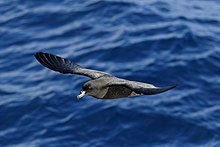Petrel
Parts of this article (those related to the Known species sections) need to be updated. The reason given is: the Known species section includes a partly outdated generic and family-level classification and doesn't cite any relevant sources published since 2004 (or any relevant phylogenetic studies published since the late '90s). (September 2021) |

Petrels are tube-nosed seabirds in the phylogenetic order Procellariiformes.
Up and down! - up and down!
From the base of the wave to the billow’s crown,
And amidst the flashing and feathery foam
The stormy petrel finds a home, -
A home, if such a place may be
For her who lives on the wide, wide sea.
O’er the deep! - o’er the deep!
Where the whale and the shark and the sword-fish sleep, -
Outflying the blast and the driving rain,
The petrel telleth her tale — in vain!
From "The Stormy Petrel" poem by Barry Cornwall[1]
Description
[edit]Petrels are a paraphyletic group of marine seabirds, sharing a characteristic of a nostril arrangement that results in the name "tubenoses".[2] Petrels include three of the four extant families within the Procellariiformes order, including the Procellariidae (fulmarine petrels, the gadfly petrels, the diving petrels, the prions, and the shearwaters), Hydrobatidae (Northern storm petrel), and the Oceanitidae (Austral storm petrel). The other Procellariiformes order are the albatross family, Diomedeidae.[citation needed]
Etymology
[edit]The word petrel (first recorded in that spelling 1703) comes from earlier (ca. 1670) pitteral; the English explorer William Dampier wrote the bird was so called from its way of flying with its feet just skimming the surface of the water, recalling Saint Peter's walk on the sea of Galilee (Matthew xiv.28); if so, it likely was formed in English as a diminutive of Peter (< Old French: Peterelle (?) > Late Latin: Peterellus < Late Latin: Petrus < Greek: Πέτρος, translit. Petros < Greek: πέτρα, translit. petra = "stone").[citation needed]
Known species
[edit]All the members of the order are exclusively pelagic in distribution—returning to land only to breed.
The family Procellariidae is the main radiation of medium-sized true petrels, characterised by united nostrils with medium septum, and a long outer functional primary feather. It is dominant in the Southern Oceans, but not so in the Northern Hemisphere.
It includes a number of petrel groups, the relationships between which have finally been resolved to satisfaction.[3][4][5][6]
- The fulmarine petrels: seven species of surface predators and filter feeders, breed in high latitudes but migrate along cool currents to the north. All but Fulmarus are essentially confined to the south, Fulmarus apparently colonised the Northern Hemisphere during the Early Miocene.
- The huge giant petrels, genus Macronectes, which are convergent with the albatrosses
- The true fulmars, genus Fulmarus
- Antarctic petrel Thalassoica antarctica
- Cape petrel Daption capense
- Snow petrel Pagodroma nivea
- The prions: A specialised group of a few very numerous species, all southern. They have a small, fulmar-like form and mostly filter-feed on zooplankton.
- Pachyptila, the prions proper
- The procellariine petrels, larger or mid-sized species feeding on fish and molluscs which are fairly close to the prions:
- Shearwaters: There are numerous species in several genera with a medium number of species.
- Calonectris
- Puffinus, which is two rather distinct groups of larger and smaller species
- Pseudobulweria
- Kerguelen petrel Lugensa brevirostris
- The gadfly petrels: These are a considerable number of agile short-billed petrels in the genus Pterodroma which include the endangered Bermuda petrel or cahow and a considerable number of forms rendered extinct by human activity.
The families Oceanitidae and Hydrobatidae are the storm petrels, small pelagic petrels with a fluttering flight which often follow ships.
The family Pelecanoididae is the four species of diving petrels, genus Pelacanoides. These are auk-like small petrels of the southern oceans.
See also
[edit]References
[edit]- ^ A Library of Poetry and Song: Being Choice Selections from The Best Poets. With An Introduction by William Cullen Bryant, New York, J.B. Ford and Company, 1871, p. 354.
- ^ "Petrels and Shearwaters | Bird Family Overview". The RSPB.
- ^ Austin, Jeremy J. (1996). "Molecular Phylogenetics of Puffinus Shearwaters: Preliminary Evidence from Mitochondrial Cytochrome b Gene Sequences". Molecular Phylogenetics and Evolution. 6 (1): 77–88. Bibcode:1996MolPE...6...77A. doi:10.1006/mpev.1996.0060. PMID 8812308.
- ^ Bretagnolle, V., Attié, C., Pasquet, E. (1998). "Cytochrome-B evidence for validity and phylogenetic relationships of Pseudobulweria and Bulweria (Procellariidae)" (PDF). Auk. 115(1 (1): 188–195. doi:10.2307/4089123. JSTOR 4089123.
{{cite journal}}: CS1 maint: multiple names: authors list (link) - ^ Nunn, Gary B. & Stanley, Scott E. (1998). "Body Size Effects and Rates of Cytochrome b Evolution in Tube-Nosed Seabirds" (PDF). Molecular Biology and Evolution. 15 (10): 1360–1371. doi:10.1093/oxfordjournals.molbev.a025864. PMID 9787440. Corrigendum
- ^ Brooke, M. (2004): Albatrosses and Petrels Across the World. Oxford University Press, Oxford, UK. ISBN 0-19-850125-0
External links
[edit] The dictionary definition of petrel at Wiktionary
The dictionary definition of petrel at Wiktionary- Petrel and shearwater videos on the Internet Bird Collection
- Agreement on the Conservation of Albatrosses and Petrels (ACAP)
